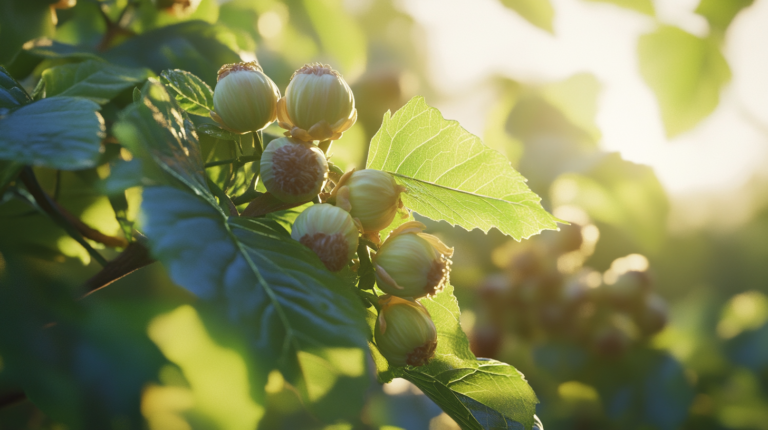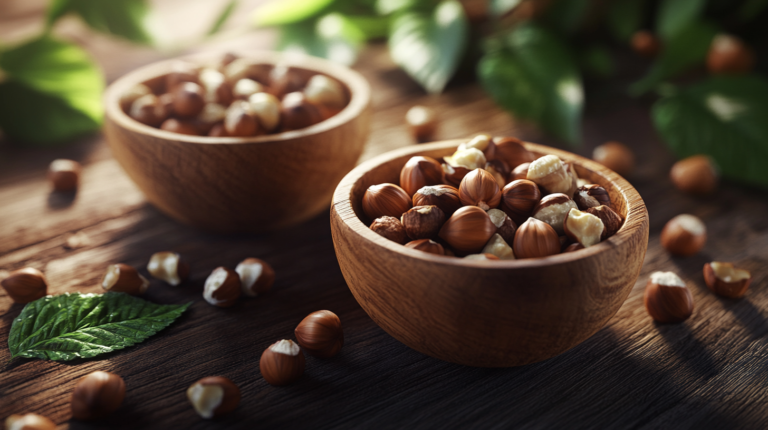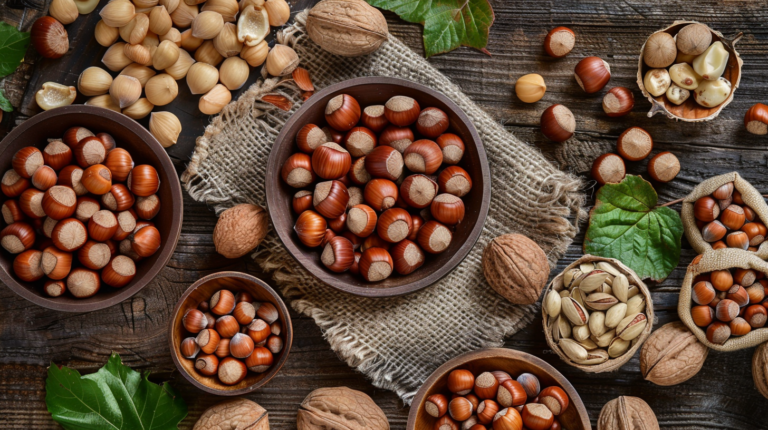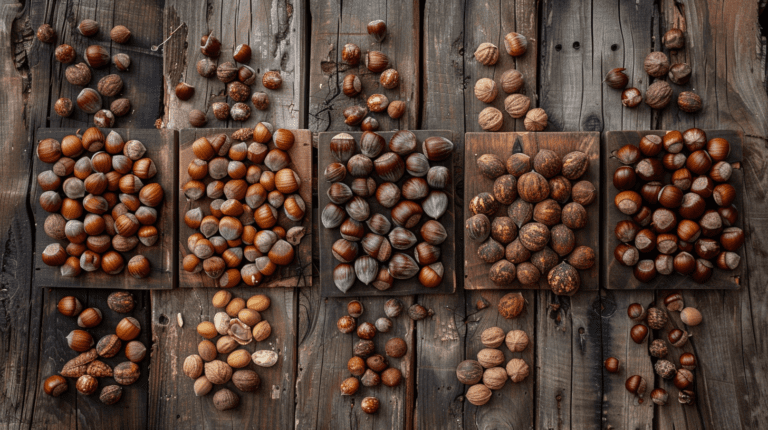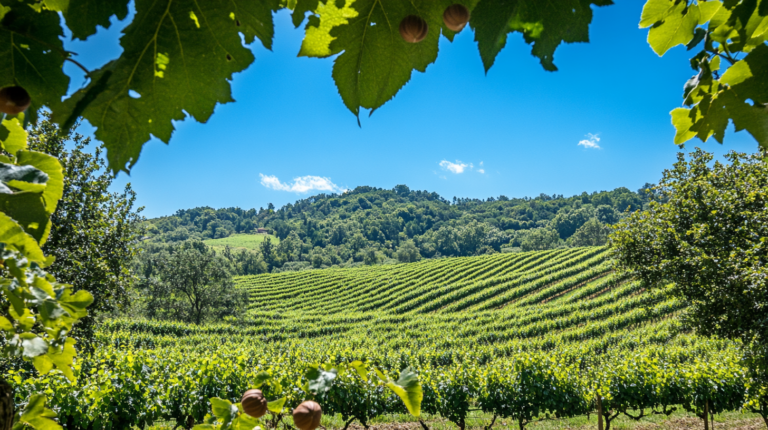Understanding the Unique Traits of the Barcelona Hazelnut
The Barcelona hazelnut, also known as Corylus avellana ‘Barcelona,’ is a prominent cultivar of the European hazelnut tree. It is highly valued for its nut quality, productivity, and adaptability. Here are the unique traits that distinguish the Barcelona hazelnut:
Nut Characteristics
Size and Shape
The Barcelona hazelnut produces medium to large-sized nuts with a smooth, thin shell and an oblong shape. The nuts are highly prized for their size and ease of cracking, making them a favorite among both commercial producers and home gardeners. Their large size makes them particularly suitable for culinary applications where whole nuts are desirable, such as in confections and roasted nut mixes.
Flavor
The nuts of the Barcelona hazelnut are renowned for their rich, buttery flavor. This makes them highly desirable for both fresh consumption and culinary uses. The nuts can be eaten raw, roasted, or incorporated into various recipes. Their rich flavor enhances baked goods, confectioneries, and savory dishes, making them a versatile ingredient in the kitchen.
Pellicle
The kernels of the Barcelona hazelnut have a coarse, brown, skin-like pellicle that is difficult to remove completely, even after roasting. This pellicle can impart a slightly bitter taste if not adequately removed. However, some processors have developed methods to effectively remove the pellicle, ensuring a cleaner, sweeter nut that is more appealing for certain culinary uses.
Tree Traits
Growth Habit
The Barcelona hazelnut tree has an upright, multi-stemmed growth habit with a rounded canopy. It typically grows to a height of 10-15 feet (3-4.5 meters) and a spread of 8-12 feet (2.4-3.6 meters). This growth habit makes it a manageable size for both commercial orchards and home gardens. The tree’s rounded canopy provides a pleasing aesthetic, adding to its appeal as a landscape plant.
Blooming
The Barcelona hazelnut is an early bloomer, producing clusters of catkins in early spring. These catkins release pollen, which is carried by the wind to the female flowers. Following pollination, the tree produces small, oval-shaped nuts encased in distinctive bracts. The early blooming nature of the Barcelona hazelnut makes it important to ensure that compatible pollinators are also in bloom to facilitate effective cross-pollination.
Productivity
The Barcelona hazelnut tree is known for its high productivity, yielding abundant crops of nuts. However, it tends to bear a heavy crop only every other year, a phenomenon known as biennial bearing. Additionally, the tree produces a high percentage of blank nuts, which are nuts that fail to develop kernels. This characteristic can be a drawback for commercial producers, as it reduces overall yield.
Climate and Soil Requirements
Climate
The Barcelona hazelnut thrives in temperate climates with cool winters and mild summers. It is suitable for USDA hardiness zones 5-8. These climatic conditions provide the necessary chill hours required for the tree to break dormancy and ensure successful flowering and nut production. Regions with extreme temperatures, either too hot or too cold, can negatively impact the tree’s health and productivity.
Soil
Barcelona hazelnut trees prefer well-drained, loamy soil with a pH range of 5.5-7.0. Proper drainage is crucial as waterlogged soils can lead to root rot and other issues. While the tree requires ample sunlight for optimal growth, it can benefit from filtered shade in regions with hot summers to prevent sunburn. Soil quality can be improved through the addition of organic matter, which enhances soil structure and nutrient availability.
Pollination
Self-Pollination
While the Barcelona hazelnut is technically self-pollinating, it is recommended to plant it in a group with at least three other varieties to maximize nut production. This is because hazelnuts generally produce more nuts when cross-pollinated with other varieties. Planting multiple varieties ensures that there is a sufficient overlap in flowering times, facilitating effective pollination.
Cross-Pollination
The Barcelona hazelnut requires cross-pollination with another compatible hazelnut variety to produce nuts effectively. Historically, the variety ‘Daviana’ was used as a pollinizer, but due to its susceptibility to Eastern Filbert Blight (EFB), it is recommended to use other resistant varieties like ‘York.’ Ensuring the presence of compatible pollinators can significantly enhance the nut set and overall yield.
Historical Significance
Origin
The Barcelona hazelnut originated in Spain and has become the most widely planted European variety in America, particularly in Oregon. Oregon’s Willamette Valley, with its ideal climate and soil conditions, has become a major hub for hazelnut production, accounting for more than 60% of the hazelnut acreage in the United States. The variety was introduced to the Pacific Northwest in the early 20th century and has since become a staple of the region’s agricultural landscape.
Industry Standard
Despite some undesirable characteristics for commercial production, such as biennial bearing and blank nuts, the Barcelona hazelnut remains the industry standard against which other varieties are measured. Its adaptability, nut quality, and historical significance make it a benchmark for evaluating the performance of newer hazelnut cultivars. Breeders and growers continue to use the Barcelona hazelnut as a reference point for developing improved varieties.
Pest and Disease Management
Susceptibility
The Barcelona hazelnut is susceptible to various pests and diseases, including aphids, filbertworms, and Eastern Filbert Blight (EFB). EFB, caused by the fungus Anisogramma anomala, is particularly problematic as it can cause significant damage to hazelnut orchards. The disease manifests as cankers on branches, leading to dieback and reduced yields. Effective management strategies are essential to mitigate these issues.
Management Practices
Regular monitoring and proper cultural practices are essential for managing pests and diseases in Barcelona hazelnut orchards. Integrated Pest Management (IPM) strategies, which combine biological, cultural, and chemical controls, can be effective. Pruning to improve air circulation, removing infected plant material, and applying appropriate fungicides are key practices for controlling EFB. Additionally, selecting resistant varieties and ensuring proper spacing between trees can help reduce the incidence of pest and disease outbreaks.
Uses
Culinary
The nuts of the Barcelona hazelnut are versatile and can be used in a wide range of recipes. Their rich, buttery flavor enhances both sweet and savory dishes. In baking, they are commonly used in cookies, cakes, and pastries. They can also be ground into a paste for making hazelnut spreads, incorporated into chocolates, or used as a topping for salads and desserts. Roasted hazelnuts are a popular snack and can be added to granola or trail mix.
Nutritional Value
Hazelnuts are rich in healthy fats, vitamins, and minerals, making them a nutritious addition to any diet. They are an excellent source of monounsaturated fats, which are beneficial for heart health. Hazelnuts also provide significant amounts of vitamin E, magnesium, and fiber. Including hazelnuts in the diet can contribute to improved cardiovascular health, better digestion, and overall wellness.
Challenges and Future Prospects
Biennial Bearing
One of the challenges of growing Barcelona hazelnuts is their tendency for biennial bearing, where the tree produces a heavy crop one year followed by a lighter crop the next. This irregular bearing pattern can complicate harvest planning and market supply. Researchers and breeders are working to develop new hazelnut cultivars that exhibit more consistent annual yields, reducing the impact of biennial bearing.
Eastern Filbert Blight
Eastern Filbert Blight (EFB) remains a significant threat to hazelnut production. The development and planting of EFB-resistant cultivars are critical for the future sustainability of hazelnut orchards. Breeding programs at institutions such as Oregon State University have made strides in developing resistant varieties, which are gradually being adopted by growers. Continued research and extension efforts are essential to combat this disease and protect hazelnut crops.
Market Trends
The global demand for hazelnuts continues to grow, driven by increasing consumer interest in healthy and natural foods. Hazelnuts are a key ingredient in many popular products, such as Nutella and other hazelnut spreads. This rising demand presents opportunities for growers to expand their operations and invest in new technologies to improve productivity and nut quality. Sustainable farming practices and organic production methods are also gaining traction, catering to the preferences of health-conscious consumers.
Climate Change
Climate change poses both challenges and opportunities for hazelnut production. Changes in temperature and precipitation patterns can affect the growth and productivity of hazelnut trees. However, hazelnuts’ adaptability to a range of climatic conditions may provide some resilience. Growers may need to adjust their practices, such as selecting more drought-tolerant rootstocks or modifying irrigation schedules, to cope with the effects of climate change. Continued research into the impacts of climate change on hazelnut production will be crucial for developing adaptive strategies.
Conclusion
The Barcelona hazelnut, with its rich history, superior nut quality, and adaptability, remains a cornerstone of hazelnut cultivation. Understanding its unique traits—from its desirable nut characteristics and tree traits to its climate and soil requirements—is essential for growers aiming to optimize their orchards. Despite challenges such as biennial bearing and susceptibility to Eastern Filbert Blight, the Barcelona hazelnut continues to be a valuable cultivar in the global hazelnut industry. Through effective pest and disease management, careful selection of pollinizers, and adaptation to changing climatic conditions, the prospects for Barcelona hazelnut cultivation remain promising. As research and breeding efforts progress, this cultivar will likely continue to play a significant role in hazelnut production, meeting the growing demand for high-quality nuts in the market.

